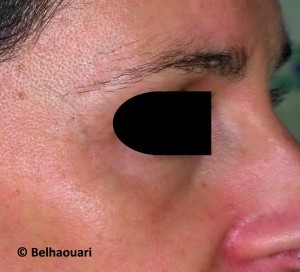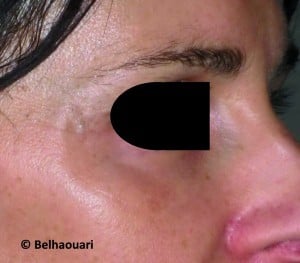What to inject?
Even if the ‘ideal filler’ does not exist, it is clear that hyaluronic acid is the gold standard product7, especially when considering the recent advances in the quality of volumising products. The authors also have experience with fat injections, with remarkable results. However, it is easier and more flexible to use hyaluronic acid as greater technical, surgical and anaesthetic requirements are necessary for fat injections. Smaller particle hyaluronic acid is even more forgiving owing to the fine anatomical structure of the treated area.
The future will be shaped by further research. Developing less hydrophilic hyaluronic acid products, resulting in less water absorption, can have an impact on this area, and so minimise the risk of the Tyndall effect. The use of short chains of hyaluronic acid can achieve this goal.
Low-molecular-weight hyaluronic acid creates a more effective cross‑linking with 4-butanediol diglycidal ether (BDDE) as attachment is easier on short strings compared with high‑molecular-weight hyaluronic acid, with their long chains. With short strings, attachment is easier on the two sides of BDDE; less free chains or chains attached on one side are obtained, so avoiding the capture of water facilitated by the free chains.
The product is less hydrophilic with less water absorption, and causes less oedema, exactly as required in this area. Juvéderm® Volbella™ has such a profile. In addition, viscosity becomes superior with the more effective cross-linking. These new products will be able to be dispersed in a thin layer in areas such as the palpebromalar groove and tear trough, resulting in a natural appearance, with the additional benefit of a sufficiently long duration.
What to avoid
The two major considerations when treating this area of the face are the avoidance of over-correction and the Tyndall effect. The expert physician will obviously aim for a perfect correction (Figures 6 and 7); however, under‑correction is preferable to over-correction. The Tyndall effect causes an aesthetically unacceptable swelling and blue appearance. The hydrophilic nature of the hyaluronic acid, when placed too superficially under this fine skin, gives a blue appearance caused by light diffraction.
The injection of the product can be too excessive or too superficial to the orbicularis muscle. The injection must be controlled and very gentle. In effect, excessive pressure on the syringe or uncontrolled massage can spread the hyaluronic acid superficially, even if it has been injected at the correct depth. An important anatomical fact to remember is that muscles also age; the fibres are less compact, less homogenous and more dissociated, resulting in gaps between them. An undesired superficial migration of the product through these gaps can occur, even with a correct injection. The utmost care to avoid excessive product must be taken in older patients, when less compact and dissociated muscle with gaps is suspected. Under-treatment is most certainly preferable in patients with signs of laxity in this area, and especially when treating the older patient.
Palpebral malar grooves are more visible when there is a concurrent existence of inferior palpebral pockets/bags. Surgical treatment of these pockets can diminish the visibility of the palpebral–malar grooves. Similarly, treatment of the palpebral–malar grooves can diminish the visibility of the inferior palpebral pockets. It is the physician’s responsibility to advise which treatment is indicated to achieve the best aesthetic result.





